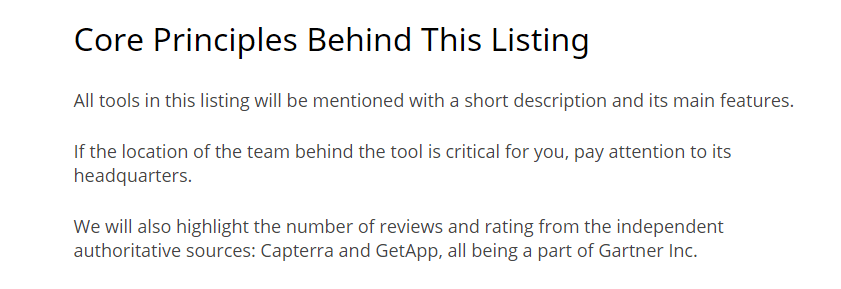Listicles are extremely popular because people love to read them.
Many content managers don’t know how to write them properly, however, and as a result, their blogs don’t bring in leads.

Readers appreciate and will share a good listicle.
In fact, a very good one can easily go viral and bring in many leads.
In this article, we’ll provide our recipe for writing a quality listicle that readers will be likely to share, telling you exactly what to do, one step at a time.
How Can Kraftblick Help Your Software Company?

- We build marketing strategies from scratch and fix existing ones. More about that here.
- We provide consultations to company owners, directors, heads of marketing and sales, marketers. This is how we do it.
See you soon
Step 1: Define the Topic
This is probably the most important step, as the topic determines the rest of the article.
Here are three ideas to help you with defining your topic.
First, understand the needs of your target audience.
You must find out who your buyer persona is, and why that person will want to read your post.
You need to know what solutions you can offer to solve readers’ problems.
Is the concept of a buyer persona new to you?
We’ve got you covered with a comprehensive post on the subject.

Second, research various services to see what content is most popular.
You may use Buzzsumo, for example, to generate new ideas for your listicle, a tool that analyzes how many shares various articles get.
Simply enter your primary keywords and you will get a list of the most popular relevant topics.
Third, read people’s comments to understand what their problems are and what information they actually need.
You can use Quora, a platform where people ask questions to be answered by others.
Again, you can search using your major keywords to find the questions related to your topic that people ask most frequently.
This tells you right away what your readers are most interested in.
Step 2: Collect Information
Make sure that you do in-depth research to find all the details related to your topic.
This is the most time-consuming part of the process, but also critically important.
Use Google efficiently, and rely only on trustworthy sources of information.
Be sure to write only about topics with which you are familiar.
If your readers discover that you are dishonest in your writing, or you are writing about subjects where you lack expertise, you will develop a bad reputation from which it is nearly impossible to recover, nothing will help your blog.
We have written a blog post that covers the crucial points of effectively researching information.
Step 3: Create a Catchy Title
The headline of your post gives your target audience a snapshot of what you plan to tell them.
It is the #1 basis for readers deciding whether or not to read the rest of your article.
It’s a good idea is to create a title before writing the post, as it will guide your writing style and the gathering of information you plan to include.
Since the title is the first engagement with your audience, it should be as catchy as possible.
According to a Copyblogger estimate, 8 out of 10 people will read only the title of a post; just 2 will continue on to reading the post itself.
A good listicle headline should do the following:
- Capture target the reader’s attention.
- Clearly define the value of the post and what information a reader will learn.
- State the quantity of information by indicating the number of items in the listicle.
Step 4: Choose a Number of List Items
 Source: commons.wikimedia.org
Source: commons.wikimedia.org
Now that you’ve studied and collected information on your topic, it’s time to decide how many distinct points you can make using it.
The format of your post influences the number of items you are going to include. Listicles can be written in the following formats:
- Checklists. These tend to be long listicles with many items. They don’t contain detailed information on a topic, instead providing links to more in-depth resources.
- Guides. These can be long or short, depending on the complexity of the topic. In this style, the order of the items matters a lot, as guides are usually intended to be followed step by step.
- Random Lists. These are just bunches of random items, so their exact number and order is not important.
- Cheat Sheets. These can be random or organized lists. Their main feature is that they provide tips, hacks, and so forth, to help a reader simplify some process or solve a particular problem.
According to content analysis done by Buzzsumo, the magic number for a listicle is 10 – this is the number that received the largest number of social shares.
The next most popular amount of items was 23, but it had only around 25% of the shares of articles containing 10 items.
Buzzsumo also estimated that top ranking posts (as displayed in Google) contain on average 1,000 to 1,300 words.
Step 5: Decide What Information to Include
 Source: commons.wikimedia.org
Source: commons.wikimedia.org
Remember that 90% of the time, people will have already read something on the topiс that you’ve chosen.
Your readers will likely judge your article on the basis of how it compares to what they’ve read before.
For this reason, research your competition.
Analyze your competitors’ articles to find out which points they didn’t cover.
Make your posts more useful and detailed than those of the competition.
Consider, for example, how we’ve put this advice to work in creating our listicle “28 SaaS Blogs To Follow If You Care About SaaS Marketing.”
We discovered that most articles on similar to our topics merely describe company blogs and provide links to some of the company’s posts.
To make our own article more informative, we decided to include additional information such as the number of posts per month, words per article, popular post types, and so forth.
This lets our readers estimate how much content the blog publishes on a monthly basis, and how much time it will take to read a post.
It’s also a good idea to include pictures, which will entertain your readers and make it easier for them to read the text.
Blog posts with pictures get 94% more views than those without.
Step 6: Structure Your Post
 Source: pixabay.com
Source: pixabay.com
Structuring your post is essential for you, as it allows you to easily organize your train of thought.
It’s also important for your reader, to help them follow that train.
Readers avoid articles that are just “walls of text” without logical divisions or sections.
There are two options for structuring your items:
- Bulleted Listicles. This type can be used for posts containing items, that don’t need to be in any specific order. Remember, however, that if you use bullets, your post should not be too long, or the reader may get lost.
- Numbered Listicles. This is a preferable way of listing items – especially if there are many of them – as it gives your readers a specific idea of how much they’re going to learn from your post.
Our advice is to combine items into groups and provide a short table of contents at the beginning, which will tell the reader what information you’re going to cover.
For example, see our listicle “60 SaaS Directories & Review Websites and How To Get Listed There.”
The post does contain 60 items, and it takes time just to scroll through it, so it starts with a table of contents.
Step 7: Write an Opening and Closing

Openings and closings of the listicle may not seem important as long as you’ve done great research and the post itself seems extremely useful.
However, most expert writers would disagree with you on this point.
Consider, for example, what Neil Patel, a lifelong content evangelist and co-founder of Kissmetrics, Quick Sprout, and Hello Bar, has to say on the matter:
“If your introduction is weak, it’ll discourage the reader from reading further – even if the title was captivating. You could have a great blog post, but if the intro doesn’t cut it – the rest of the content won’t.”
Your opening should be just as captivating as the title. Keep in mind that there may be many similar listicles on the Internet, and you want the reader to choose your post over others.
Neil Patel advises the following with respect to the opening:
- Use a hook that will capture your reader’s attention at once. It should be brief and to the point.
- Make a transition from your hook to the topic of your article.
- State your thesis, the reason why readers should want to read your post.
We would like to add that when writing the opening of a listicle it is critical to describe its methodology.
Clarify which points you considered, and why you chose them for your listicle.
This is how we did it for our article “30 SaaS Marketing Reporting Tools that CMOs Should Give a Try: Dashboards.”

As for closings, Patel says,
“If your conclusions aren’t powerful, they’ll weaken your whole article.”
Closings are as important as openings, and should do the following:
- Repeat the essence of the whole listicle, or what you believe your readers need to remember.
- Not add any new information that hasn’t been mentioned in the post, only summarize what has been previously said.
- Encourage your readers to share their feedback or experience in the comments section.
Bonus! Step 8: Overcoming Common Listicle Problems
 Source: flickr.com
Source: flickr.com
Listicles are often considered the easiest type of blog posts to write, but they have some common pitfalls.
Here are some useful tips that can help you avoid these problems:
Do not mix numbered and bulleted lists
Once you select either bullets or numbers, stick with your choice for the entire article.
Doing otherwise, you will confuse your readers.
If there are too many items, divide them into groups
We discussed this in the structure section, but it is important enough to emphasize again.
Think about a really long listicle, with 40, 60 or even 100 items.
How many people do you think will read a single list of this length to the end? Not many.
Make it easier for readers to digest large numbers of items by combining the ones with common elements into groups.
Be consistent when describing the items
Here are some considerations on this point:
- Try to keep the descriptions of items similar in length.
- Consider the same points when describing an item.
- Use the same style throughout the text, i.e. the same subhead style to highlight significant parts, bold or italics to draw attention to important items, and so forth.
See how we cope with these potential difficulties in our listicle “30 SaaS Marketing Reporting Tools that CMOs Should give a try: Dashboards.”
Wrapping Up
Listicles are a great type of content for a company blog, but many content managers don’t know how to write them properly, which makes them ineffective.
To write a listicle like a pro, make sure that you follow the right steps:
- Define the topic to match your buyer persona’s needs.
- Collect relevant and accurate information.
- Create a catchy title, since this is what will grab readers’ attention.
- Define the number of items and the format of your listicle.
- Decide what information to include so that you do not duplicate your competitors’ listicles.
- Structure your post to be convenient for your readers’.
- Write an opening and closing that will both attract readers and encourage them to take action.
How many listicles have you published on your blog?
What do you feel are the best tips for writing a captivating listicle?
Share your opinions in the comment section.
